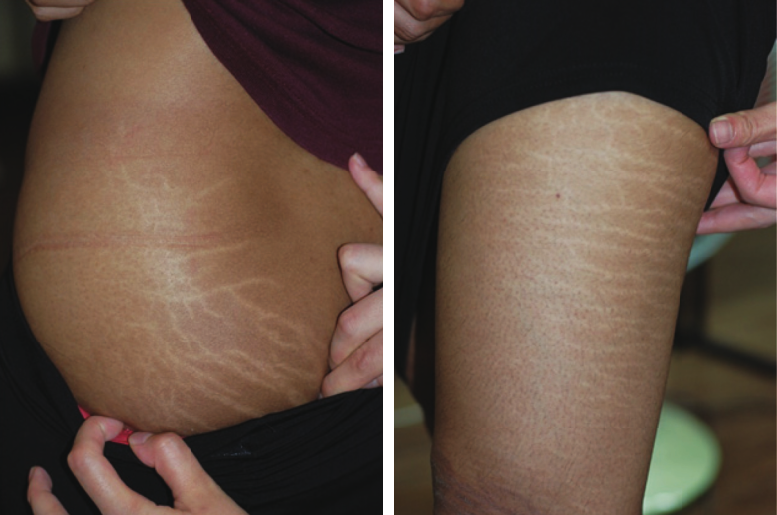
There is a saying that beauty is only skin deep but we have to admit that looks are very important in life. We are bombarded with Figures of beautiful men and women by the media. Naturally, this leads to many people spending a lot of time and money on beautifying their body. Quite often people with obesity achieve a huge weight reduction in a short period of time. A sudden weight loss like this can cause stretch marks. Stretch marks are like visible evidence of fast weight loss and although they are not a medical concern, they can be a serious aesthetic problem.
Stretch marks, or striaedistensae, is related to physiological, pathological or iatrogenic increase in glucocorticoid steroid. Skin expansion or growth can be a secondary cause. It can also develop in relation to puberty, pregnancy, drastic weight change, body building, Cushing’s syndrome, chronic wasting disease, and adrenaline cortical hormone treatment, etc.

Figure1. Stretch marks before treatment.
In the early phase, red or purplish linear indentations appear which gradually turn pale and less visible with time. The most frequently affected sitesinclude the thigh, hips, abdomen, inguinal area, and breast. Stretch marks are characterized by epidermal contraction, and dense collagenous fiber of the dermis parallel to the epidermis. Changes in elastin fiber differ throughout time. Upon histological examination, stretch marks can be described as separation of dermal tissues. The dermis is sturdier than the epidermis or subcutaneous fat which it comes between. Stretch marks develop when internal tension rises and causes the tough dermis to tear apart. Many attempts have been made in the field of medicine to treat stretch marks including laser, glycolic acid, and microdermabrasion, etc. Topical tretinoin has been found to have a teratogenicity in FDA’s animal research. Carboxytherapy is also used to treat stretch marks but without clear benefits. In short, there are no clearly effective treatments for striaedistensae. Tattooing the lesion to restore the skin’s original color can be a new remedy to this difficult skin condition.
[Advertisement] Reandnè Thread Series – Manufacturer: GTG KOREA(www.gtgkorea.co.kr)
Pre-tattooConsiderations
Stretch marks are categorized as a scar. Therefore, the tattoo procedures used in scar removal can be applied to stretch marks as well. However, vitiligo and hypopigmentation are caused by pigment abnormality but stretch marks involve dermal damage. Therefore special considerations should be given. For example, in hypopigmentation, the goal is to match the color of the lesion to the surrounding skin. On the other hand, hypopigmented scars, such as stretch marks, you should address histological abnormalities underneath the skin surface to achieve the best results. One of the most frequently asked questions during consultation is whether the tattoo ink will stay in the scar tissue. I answer that the scar tissue can hold larger amounts of tattoo pigments or very little depending on its type. This also depends on the maturity of the scar and the site of the scar. Also, an overly aggressive approach by a doctor who does not have clear understanding of the scar can lead to negative results.




















